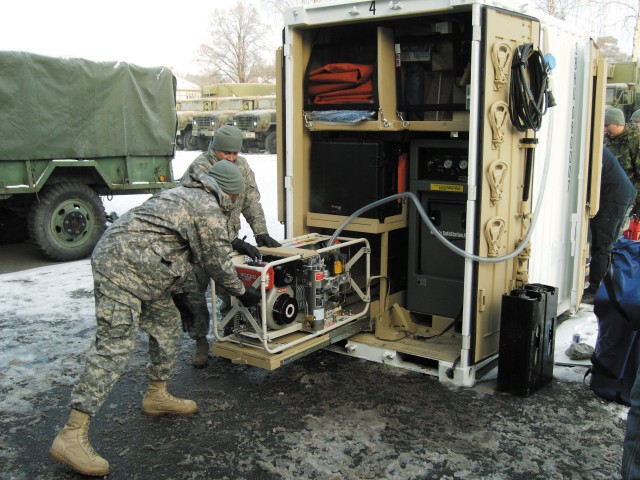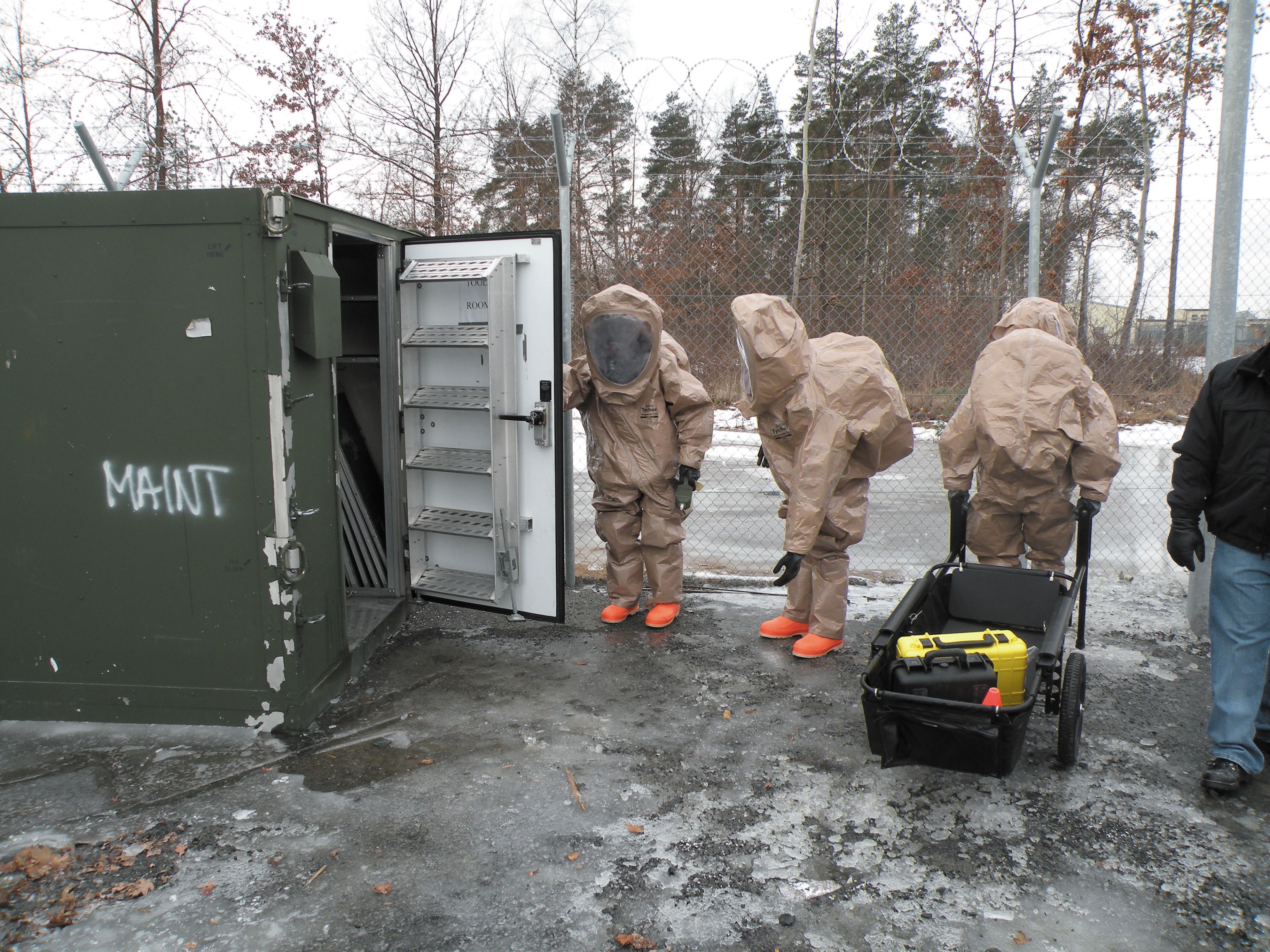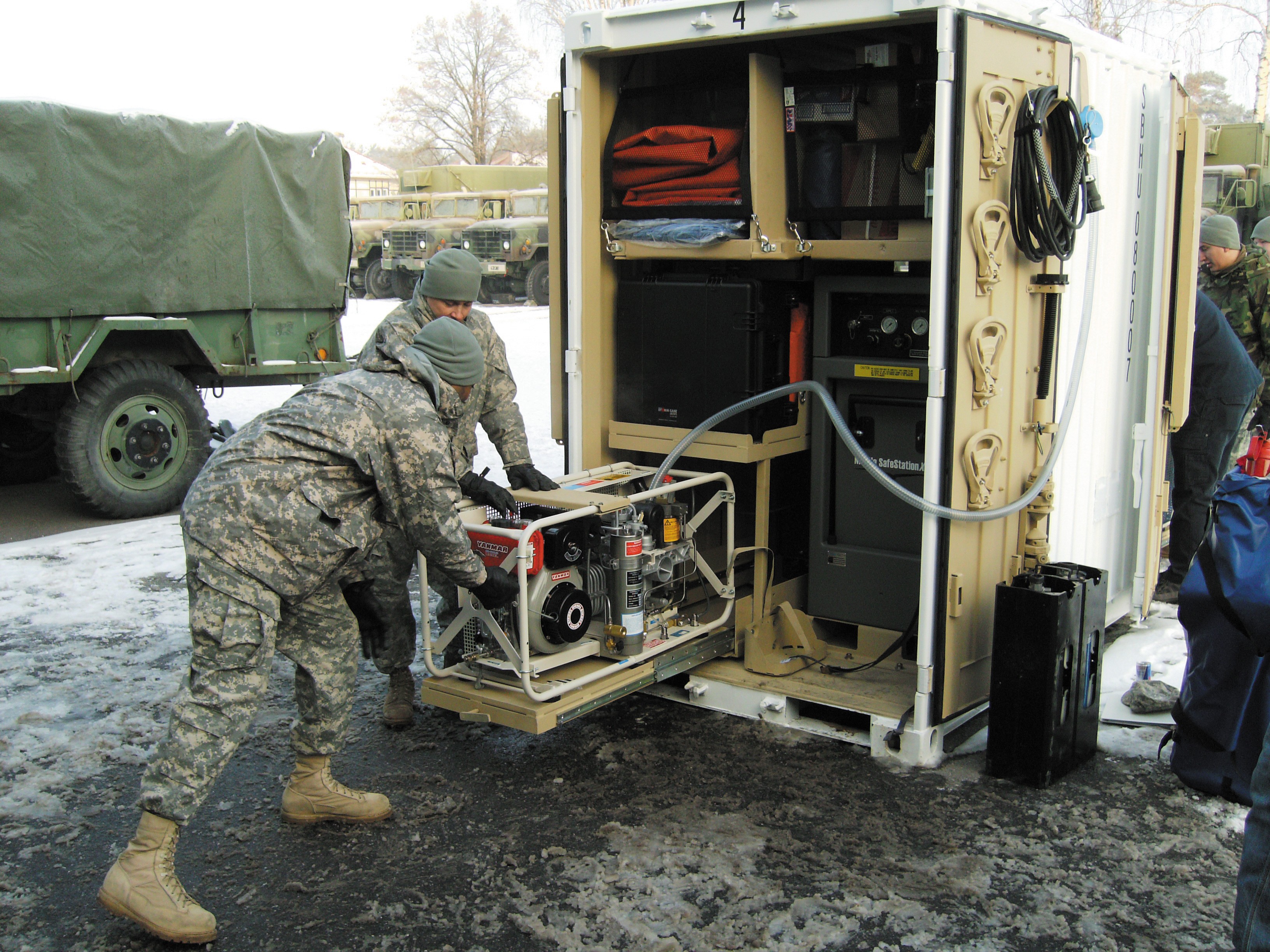The Joint Chemical, Biological, Nuclear, and Radiological community celebrated a milestone in March when the 12th Chemical Company in Grafenwoehr, Germany, became the first U.S. military unit to field a Joint Nuclear, Biological and Chemical reconnaissance system tailorable to mission requirements. The ceremony was held one day after the 21st anniversary of the worst chemical attack on a civilian population, when Saddam Hussein killed more than 5,000 Kurds in 1988.
The Joint Nuclear, Biological, and Chemical Reconnaissance System, or JNBCRS, was presented to the unit by Col. Kyle Burke, the Joint Project Manager for NBC Contamination Avoidance, Joint Program Executive Office for Chemical and Biological Defense during a handoff ceremony.
The JNBCRS is comprised of CBRN sets, kits and outfits. The system consists of both commercial and government off-the-shelf equipment to provide personnel protection from CBRN hazards (including toxic industrial chemicals and materials), CBRN detection, presumptive identification, sample collection, decontamination, marking and hazard reporting.
The 12th Chemical Company is part of Special Troops Battalion, V Corps, at Grafenwoehr. Lieutenant Colonel Khalil Karadshi, V Corps deputy CBRN officer and Sgt. Maj. Mark Barron, V Corps CBRN sergeant major, attended the ceremony. Other attendees included members of U.S. European Command's Emergency Management Assessment Team and Chemical Corps Soldiers from the nearby 2nd Stryker Cavalry Regiment.
The JNBCRS increases the Joint Force capability to conduct dismounted CBRN reconnaissance in confined spaces and terrain that is inaccessible to CBRN reconnaissance vehicles, to characterize hazardous material events or accidents, and to conduct weapons of mass detection or denial operations. The JNBCRS enables Joint Forces to detect and identify CBRN contamination and collect samples for confirmatory analysis in support of strategic WMD elimination and interdiction operations, homeland defense consequence management operations and tactical force protection operations.
A basic mission for 12th Chemical Company Soldiers and future JNBCRS users would involve donning personal protective gear, loading up with hand-held sensors, sample-collection devices and hazard-marking devices and walking into a suspected CBRN contaminated environment. While in this "hot" zone, the Warfighters would search for WMD material. If found, a sample would be collected, the location marked and the occurrence reported. Upon exiting the contaminated environment, the Warfighters and their equipment would be decontaminated and the sample sent off for laboratory analysis. All of this is accomplished with capability provided via JNBCRS. Fundamentally, JNBCRS turns a Warfighter into a mobile platform for CBRN sensors and equipment . . . a "Soldier-borne" system.
On March 10, 2008, the Army validated V Corps' Operational Need Statement for a dismounted CBRN reconnaissance capability specifically for the 12th Chemical Company, U.S. European Command's only organic Chemical Company. Joint Forces have operated, and continue to operate, in environments containing toxic industrial chemicals and toxic industrial materials posing threats to Warfighters, civilians and the environment. In many instances, TICs and TIMs have posed a greater actual threat than that of traditional WMD. Joint Forces have encountered situations ranging from unknown dangerous chemicals used in improvised explosive device labs and factories to abandoned unknown bulk hazardous material storage areas.
The need to detect TICs, TIMs, and CBRN threats continues to increase as Joint Forces encounter non-standard and unique situations involving toxic and unknown chemicals that are undetectable and/or unidentifiable by standard Joint Force detection and protection capabilities. In short, there is a dismounted CBRN reconnaissance capability gap across the Joint Force.
In addition to V Corps' ONS, other congruent urgent need statements have been validated and approved for JPM NBCCA to field a limited quantity of equipment sets, throughout 2009, under its JNBCRS program.
This effort to field equipment sets in support of urgent needs is the initial phase (i.e. Urgent Need Phase) of the multi-phased JNBCRS program. Each of these equipment sets is sized for squad-level operations and is integrated into two transportable, environmentally-controlled quadcon shipping containers. These equipment sets will provide dismounted Warfighters and homeland defenders in select Army Chemical units of the Active and Reserve Components with a CBRN reconnaissance capability providing commanders with battlefield and event awareness.
Joint Project Manager NBC-CA fields relevant operational capability to the Joint Warfighter at a relevant time. Under the command of the Joint Program Executive Office for Chemical and Biological Defense, JPM NBC-CA is responsible for the development, production, integration, testing and fielding of CBRN detection, obscuration and reconnaissance systems.
Joint Project Manager NBC-CA is partnering with the Edgewood Chemical Biological Center's Advanced Design & Manufacturing Division, a component of the U.S. Army Research, Development and Engineering Command, to design, produce, field and sustain the equipment sets of the Urgent Need Phase. This partnership represents an entirely government in-house approach to executing the Urgent Need Phase. ADM provides integrated development services specializing in accelerated acquisition activities. Joint Project Manager NBC-CA's systems acquisition expertise coupled with ADM's engineering and fabrication expertise make it a certainty that the JNBCRS Urgent Need Phase provides a war-winning capability to the Joint Force.
Upon receiving the first validated urgent need statement, a Joint Urgent Operational Need Statement from U.S. Northern Command, the JNBCRS Urgent Need Phase began with reviewing after action reports from Multi National Corps - Iraq, conducting market research, interviewing Warfighters, reviewing test reports and gathering lessons learned from experiments and similar capability in the field. All of that resulted in a design to facilitate rapid fielding of suitable capability.
As the welfare of the Joint Warfighter is of paramount concern, a Capabilities and Limitation Report and a Safety Confirmation from the Army Test and Evaluation Command and a Health Hazard Assessment from the Army Center for Health Promotion and Preventive Medicine were required prior to fielding an Urgent Need system. Thus, a system-level developmental test, an operational assessment (with 12th Chemical Company providing the system operators), and a component-level safety evaluation of the Urgent Need Phase system design were conducted.
Satisfactory results permitted fielding with the 12th Chemical Company being the first recipient of JNBCRS. As an integral part of fielding, JPM NBCCA provided 40 hours of New Equipment Training to 39 Soldiers of 12th Chemical Company at their home station in Grafenwoehr. In addition to NET, the Army CBRN School exported their three-week-long Dismounted CBRN Reconnaissance Course, via a Mobile Training Team from Fort Leonard Wood, Mo., to Grafenwoehr to provide HazMat Awareness, Operations, and Technician Certification training to 12th Chemical Company as part of fielding.
The MTT certified 35 Soldiers as HazMat technicians, which was the first time a Defense Department training institution certified Warfighters as HazMat techs in the field away from the institution.
Today, the JNBCRS program is meeting urgent operational needs, delivering systems to the Army's V Corps in Europe and units in the 48th Chemical Brigade in advance of future deployments and to Joint Forces in NORTHCOM in support of their CBRN Consequence Management Response Force mission.
Subsequent phases of the JNBCRS program will develop and deliver a new design fully tested and proven to meet joint objective and threshold capabilities to include integrated logistics support. On September 26, 2008, the $711M contract to execute these subsequent phases was awarded, which solves for the non-standard, uncommon, non-integrated, unverified, non-scalable, and unsupported commercial-off-the-shelf based applications to Joint Force dismounted CBRN reconnaissance. JNBCRS pushes key capability to the frontline fight against terror on the integrated battlefield and the home front.




Social Sharing